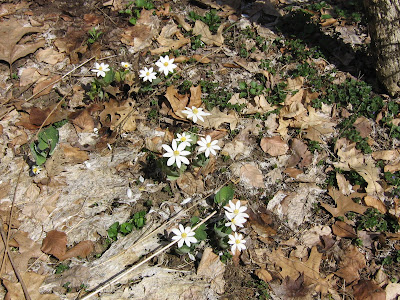

 Did I say 11? I meant 25. What I didn't see was how many little babies were nestled underneath!
Did I say 11? I meant 25. What I didn't see was how many little babies were nestled underneath!OK so I am a bit obsessed with this plant. I watch her every year, in endless awe of her beauty and sensual embrace. I have had folks write me in question of offering a bloodroot salve for sale, but I have never harvested Bloodroot. The application of bloodroot for the curing of cancerous skin spots is somewhat documented, with both success and distress. Some report great pain and burning of holes in the skin, and some report complete healing. I would do some serious research before I tried it. There is an excellent account of Bloodroot (Sanguinaria Canadensis) in the compilation book "Planting the Future" the entry written I think by Brooke Medicine Eagle.
I have however, as I got to do with my Jr. Herbalists last Friday, unearthed the incredible root to study. She grows laterally, technically a rhizome, and is easy to uncover from the one or two inches of soil. I have found it to be anywhere from a few inches long to several, varying in thickness from skinny to maybe 1 1/2 inches. And yes, when you break it, it bleeds the most riveting crimson color you can imagine.
This end tip of the root, if you were to harvest a little for some reason, is the bit you could take. The rest of the plant can still grow and reproduce. But as an at-risk plant, I would check with your local regulations on whether this is legal or not, and use common sense as to whether there is enough for you to take a few snippets.
The root has also been used, and perhaps still is, in oral care. It is said to strengthen and repair gum tissue, and prevent gum disease. I know herbalists who add a little of this tincture to their mouth rinse. This potion definitely warrants a 'do not swallow' label. It is said to be dizzying and in regular quantities toxic. The fresh juice of the plant can also give sensitive skinned ones blisters. I have not had it happen, but my little neighbor girl learned her respect-for-nature lesson with this plant quite expressly. The Latin genus name: Sanguinaria, means blood, appropriately, and although obvious when looking at the behavior of the root, could also indicate a native use relating to the blood.
Bloodroot likes loamy, partly shady soil. I usually find her in the woods or the periphery thereof.
I am convinced that she only grows where the fairies are.
Despite her threatening claims, she is certainly medicine. But all you have to do is just watch her.
No comments:
Post a Comment